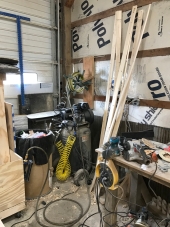posted 11 years ago
Four things influence the amount and quality of the draft in a wood burning stove/appliance,
1. Height. This one is pretty linear. Double the height, double the draft. If it's still not giving good draft, put another piece of pipe on top. That's why your stove
won't draft right now. The chimney is too short.
2. Diameter, or, more properly, cross sectional area. If the chimney is too small, it won't work right. It it's too big, it won't work right either. A typical
barrel stove should do fine with a 6" chimney. Your mileage may vary. Every install is a little different.
3. Corners/kinks/angles less than vertical. If you have too many elbows, you will have draft problems, and you'll need more height to compensate.
4. Temperature difference. A chimney is a thermosyphon device. The hotter the fire, and the colder the outside temperature, the bigger the draft. One of the not-so-obvious consequences of this is
a chimney that runs inside the house until it goes through the roof, generally runs better than a chimney that goes out through the wall, and then up. The reason is the outside chimney looses a lot of heat,
and the draft depends on the temperature differential from the very top, compared to the stove itself.
The barrels last a lot longer if you put a layer of brick, better yet firebrick to protect the thin sheet metal right where the fire sits. An alternate method is to leave an inch or three of ashes on the bottom. Ashes are a surprisingly good insulator against fire.
It never hurts to get someone with experience to inspect your setup. Housefires -suck-...
troy



























